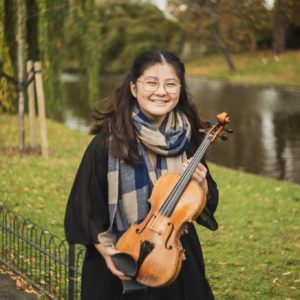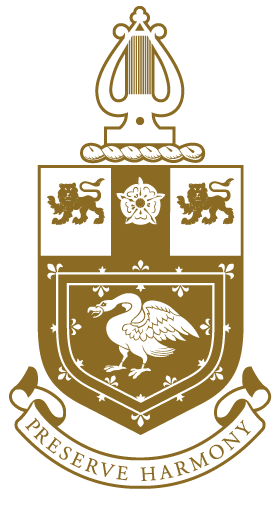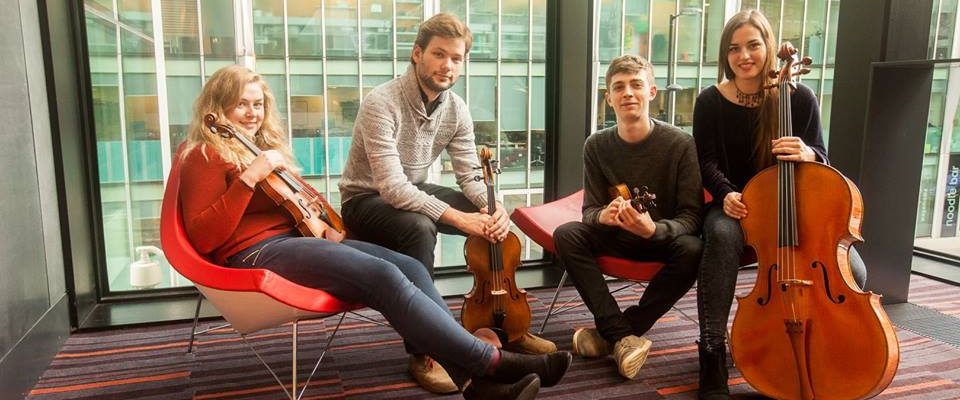Young Artist Interview: Inis Oírr Asano (Viola)
 Violist and recorder player Inis Oírr (pronouned Aneesha) Asano is an award-winning soloist, chamber and orchestral musician. In 2022, Inis Oírr won the Company’s Biddy Baxter & John Hosier Music Trust Scholarship in recognition of her outstanding talents. She later made her Wigmore Hall debut performing contemporary string trios with Nash Ensemble cellist, Adrian Brendel. Never one to shy away from a fresh challenge, Inis Oírr tells us more about her life on and off the stage.
Violist and recorder player Inis Oírr (pronouned Aneesha) Asano is an award-winning soloist, chamber and orchestral musician. In 2022, Inis Oírr won the Company’s Biddy Baxter & John Hosier Music Trust Scholarship in recognition of her outstanding talents. She later made her Wigmore Hall debut performing contemporary string trios with Nash Ensemble cellist, Adrian Brendel. Never one to shy away from a fresh challenge, Inis Oírr tells us more about her life on and off the stage.
Hello, how are you and where are you currently?
Hi, I’m doing well – very busy and happy! I am currently studying with Yuko Inoue and Martin Outram on the Professional Diploma course at the Royal Academy of Music. Alongside this, I am a chamber fellow with my string quartet, Elmore Quartet, at the Guildhall School in London.
During my master’s at the Academy last year, I was also doing many hours of chamber music coaching at the RNCM in Manchester as a Junior Fellow. I absolutely loved last year and am enjoying the student/fellow double life again this year, luckily all in the same city this time!
You’ve had a busy couple of years. What have been the highlights?
A few of last year’s highlights include my experience as a fellow at the RNCM (gratefully supported by the Biddy Baxter and John Hosier Trust); joining Glyndebourne Tour Orchestra last autumn; working with the unconducted string orchestra, 12 Ensemble; and a recent trip to Switzerland with my quartet to study with the Jerusalem Quartet.
Before this year, I had zero experience of teaching or coaching students who were beyond high school level – it was something completely unfamiliar to me. Alongside diving straight into the serious quartet life, I also immediately found the biggest passion for chamber coaching!
Whilst finding my feet in Manchester in Autumn 2022, I joined the viola section of the Glyndebourne Touring Orchestra and had the chance to perform all the ‘La Boheme’ shows whilst also being a deputy in some performances of Mozart’s ‘Marriage of Figaro’. During that year, I was invited to join 12 Ensemble in recording their album, for which the main piece was Strauss’s ‘Metamorphosen’. It felt like a dream to join the most outstanding group of players, and the piece, alongside ‘La Boheme’ and ‘Marriage of Figaro’, has a special place in my heart from working on it so intensively.
My busy academic year ended in August 2023 with an incredible residency in Crans-Montana, Switzerland, studying with the Jerusalem Quartet. Working with a quartet who have created such a legacy was unbelievable. The intensity and amount of information I was trying to work through was new to me, and I loved how crazy a week it was.
What ensembles are you currently performing with?
For as long as I can remember, I have never been a decisive person and I love trying everything; experiencing music making in both large and smaller groups, and playing a lot of different instruments. I think all of these things inform each other!
A dream of mine has always been to have a versatile career, and I am happy to be living the start of that so far! I am very lucky to have found my quartet; we are currently pursuing a career together and have the chance to perform and study abroad more than I could have imagined. The dream is perhaps to be playing the staples of string quartet repertoire in the greatest variety of venues all over the world. We are currently enjoying working on Webern and Mozart together – two composers that, as a long-term Mozart lover, I didn’t think I would enjoy at an equal level!
Whilst at the Academy, I formed Clio Duo, a viola/piano duo, with a fellow Musicians’ Company Young Artist. We are exploring as much repertoire originally written for viola and piano as possible – the list isn’t as limited as one would imagine, and with my teachers, researching the genre of English ‘Fantasy’ sonatas – e.g. works by York Bowen, Arthur Bliss, Arnold Bax and Vaughan-Williams. I am really enjoying having a chance to play a more technically demanding and main-character part whilst still treating the duo as chamber music and stepping away from the quartet for a bit.
What violists or musicians have the most influence on your playing style?
I definitely have to include my teachers, Paul Silverthorne, Yuko Inoue and Martin Outram! Paul was my first viola teacher at the RAM. He taught me the importance of open-mindedness and creativity in making the viola shine! Yuko has taught me to slow down and not to rush everything, which I tend to do… Martin was my chamber coach before I joined his viola class. He is currently helping me to fine-tune my technical skills. Recently, I have had a few chances to play to Martin’s former student, Timothy Ridout, whose albums I listen to daily.
Alongside this, I owe a lot to Catherine Manson who introduced me to the viola, to good chamber music and to an ego-less world of music; Pamela Moody, my first chamber coach in high school who persuaded me to pursue the viola when it was only a dream of mine; and to Barbara Law and Yumi Sasaki, my JRAM recorder and violin teachers. I also owe a lot to Martin and Catherine for opening my eyes to how bowings have the power to change the meaning of the music, instead of just a simple down and up bow!
If you had to choose between the viola or recorder, which would it be?
I was 17 when I got a call from the Academy offering me scholarships to study either viola or recorder; I had auditioned for both, (but viola secretly without telling anyone). I was asked over the phone ‘You don’t have to decide now, but off the top of your head, what would you say?’. I remember sitting on the train on the way home from school with an ice cream in my hand saying: ‘I guess, viola’. The opportunities I have had and the people that I have met from becoming a viola player have exceeded my expectations so it must have been the right choice!
What would you say to people who think the recorder isn’t a serious instrument?
The recorder is definitely an interesting instrument – sort of like the piano, but more accessible because of its size and mechanism. It is an ‘easy-to-play’ instrument in that it is easier to immediately make a nice-ish sound. For those who don’t understand how amazing and unique the recorder is I would say explore recorder repertoire! Start by listening to some of the current professional recorder players, including my previous teacher Anna Stegmann who is incredible. With her ensemble, Royal Wind Music, they play all the sizes of recorder in existence which most people won’t know about!
What music are you rehearsing or listening to currently?
Being a classical musician, my list of current repertoire includes a lot of the canonic works for viola, viola and piano, and string quartet. Some highlights I recommend to everyone are: Sergey Malov’s Bach Suites on violoncello da spalla, Chiaroscuro Quartet’s Haydn and Beethoven quartet albums, and Vision String Quartet’s ‘Spectrum’ album. A non-classical favourite that is always plugged into my ears are band ‘Kawala’.
Interview by Suzy Willmott
Suzy is freelance copywriter who works with the Musicians’ Company





